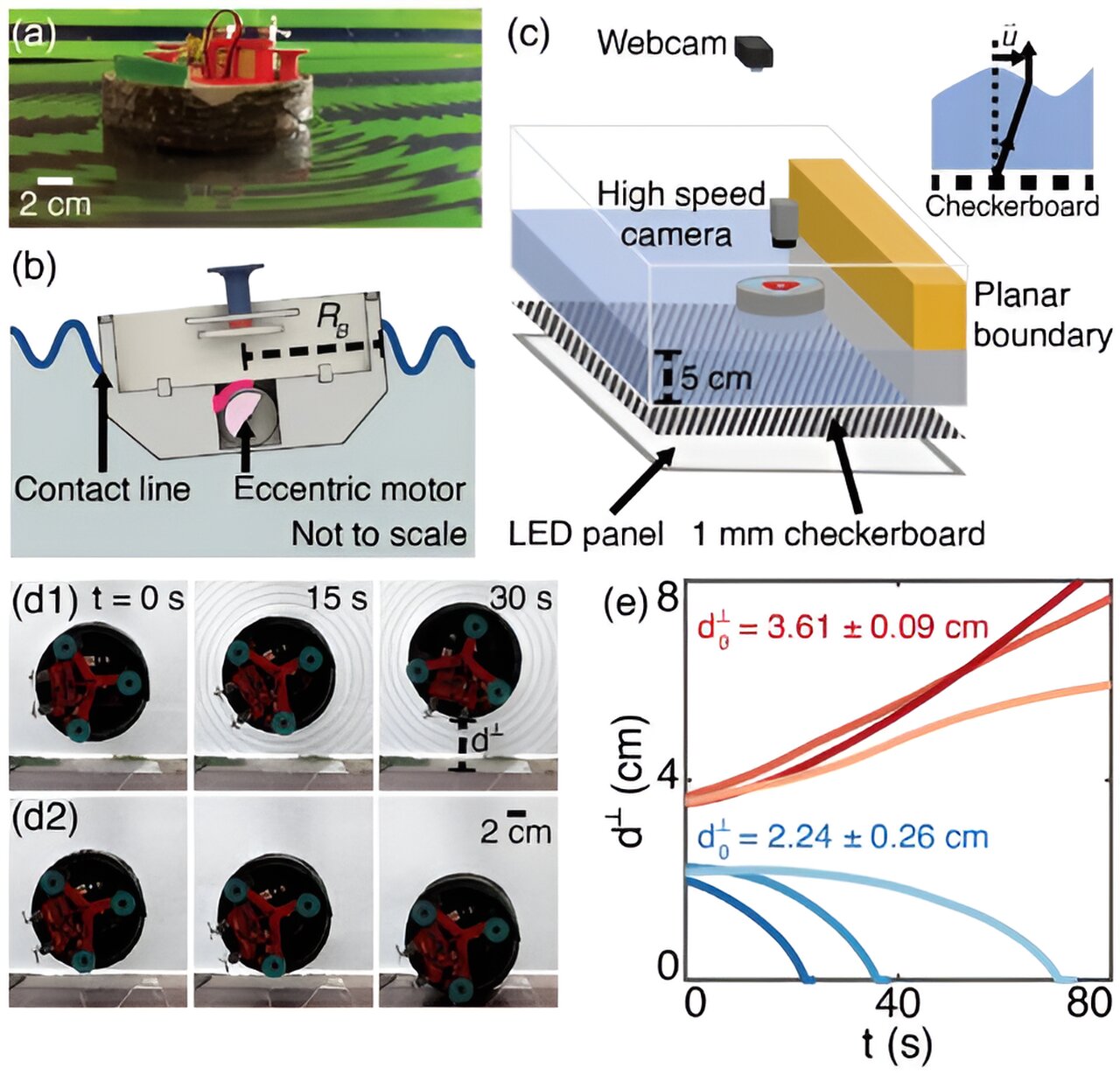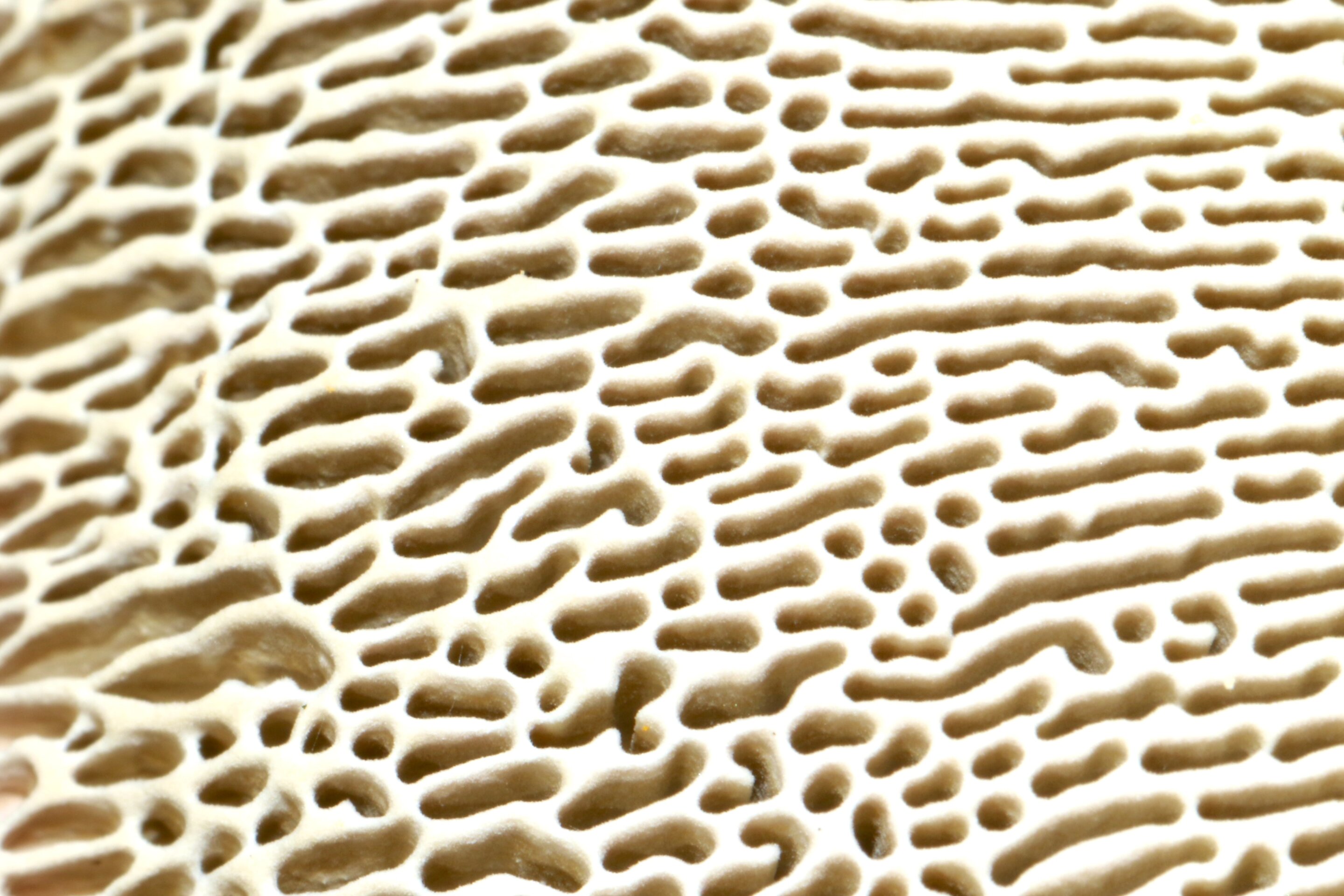#An oscillating robot can propel itself via the reflection of water waves


Odd things can happen when a wave meets a boundary. In the ocean, tsunami waves that are hardly noticeable in deep water can become quite large at the continental shelf and shore, as the waves slow and their mass moves upward.
The Casimir effect is the attraction of two uncharged, parallel plates because virtual quantum mechanical waves with wavelengths greater than the plate separation are excluded between them, so virtual fields outside the plates push them inward. Parallel plates partially submersed in water attract one another as longer wavelength momentum-carrying water waves are excluded from the central region. (Speculation about a maritime Casimir effect between docked ships is still under debate.)
Now scientists have shown that a floating, symmetric oscillating robot will experience forces when it comes close to a boundary. These forces can be used for self-propulsion without the need for more typical mechanisms such as a propeller.
The study is published in the journal Physical Review Letters.
Led by Ph.D. student Steven W. Tarr at the Georgia Institute of Technology, the team built a 3D-printed circular float 12 cm in diameter with a mass of 368 g. Onboard, they attached battery-operated motors that vibrate the boat with a controllable frequency, producing a vibrating motion along the fore-aft (roll) axis. When powered on, the craft produced a series of symmetrical waves on the water surface, all the same wavelength, radiating away from it.
An acrylic sheet was placed nearby in the water to act as a boundary, sufficiently long to effectively create a one-dimensional system, so only the boat’s movement perpendicular to the wall needed to be monitored. Far from the wall (relative to the size of the boat and the wavelengths of the water waves), there was no net force on the boat. But close to the wall, the wave-generating boat was observed to experience either an attractive or repulsive behavior, depending on its initial distance from the wall and the frequency of water waves being generated.
Researchers used a webcam to record the boat’s movement and measured its lateral movement (perpendicular to the wall), while also measuring its acceleration in this perpendicular direction (which was less than 100 micrometers per second-squared). Waves emanating from the oscillating boat were viewed and measured with a high-speed camera via Schlieren photography, which measures changes to a fluid’s flow rate by observing changes in its refractive index.
When it started close to the wall—about half its radius or less—the boat was increasingly attracted to the wall as its initial distance decreased and its frequency of oscillation increased (and hence so did the frequency of the water waves). In a mid-range, at an initial distance of about two-thirds of a radius and at lower frequencies, the force on the boat turned slightly repulsive, moving it away from the wall. At large distances (relative to the radius), there was no net force on the boat.
Because the acceleration was quite small, less than 10-millionths of Earth’s surface gravitational acceleration (“g”), steps were taken to isolate the forces from short-term effects from viscosity, drag on the boat due to the waves themselves, and the boat’s inertia. Still, the forces were small, below 100 micronewtons.
The net-force, self-propagation locomotive phenomenon of the waves emanating from the boat occurred as reflected waves from the wall struck the boat’s hull with sufficient energy. On the wall-side of the boat, reflected waves struck the hull with a smaller wave height (amplitude) than they left it, due to dispersion of the waves as they traveled across the water’s surface. These smaller returning waves were subtracted from the larger emitted waves, interfering and effectively decreasing the amplitude of the waves the boat emitted on the wall side.
In effect, the boat emitted asymmetrical waves, larger in the direction opposite the wall, and smaller towards the wall. This asymmetry between the two sides of the boat resulted in an attractive force towards the wall.
Further from the wall, the reflected waves had too small a height to affect net wave generation, but still carried some momentum, resulting in a slight repulsive force. Far from the wall, the reflected waves had dissipated so they provided no meaningful force.
Frequency dependence arose because while the energy of the reflected wave increased with frequency, the contact of the emitted waves with the wall led to complicated dynamics at the contact line, dissipating substantial energy and modifying the amplitude of the reflected waves.
“Our study is a terrific example of the wealth of phenomena waiting to be discovered at the interface of physics and robotics,” said Daniel Goldman, a co-author and physics professor at the Georgia Institute of Technology, who calls this field “robophysics.”
“Making and using analogies from other branches of physics (in this case, the Casimir effect in quantum field theory) can be useful in developing new approaches to robot movement analogous to our previous work on ‘mechanical diffraction’ in undulatory limbless systems,” Goldman concluded.
Steven W. Tarr et al, Probing Hydrodynamic Fluctuation-Induced Forces with an Oscillating Robot, Physical Review Letters (2024). DOI: 10.1103/PhysRevLett.132.084001
© 2024 Science X Network
Citation:
An oscillating robot can propel itself via the reflection of water waves (2024, March 9)
retrieved 9 March 2024
from https://techxplore.com/news/2024-03-oscillating-robot-propel.html
This document is subject to copyright. Apart from any fair dealing for the purpose of private study or research, no
part may be reproduced without the written permission. The content is provided for information purposes only.
If you liked the article, do not forget to share it with your friends. Follow us on Google News too, click on the star and choose us from your favorites.
If you want to read more Like this articles, you can visit our Science category.


